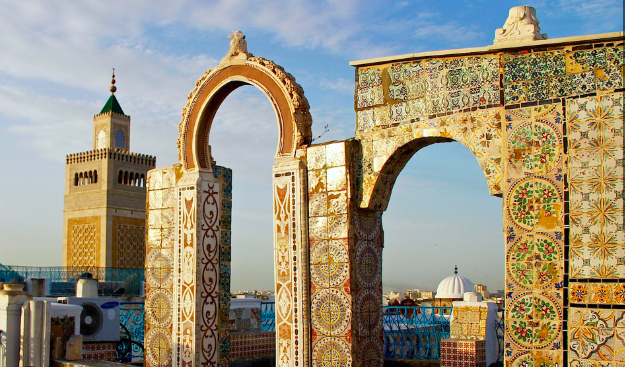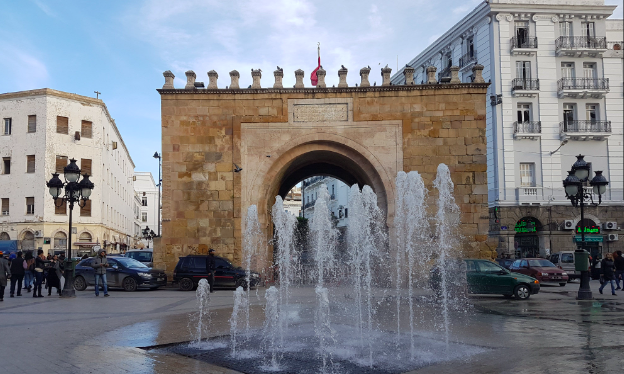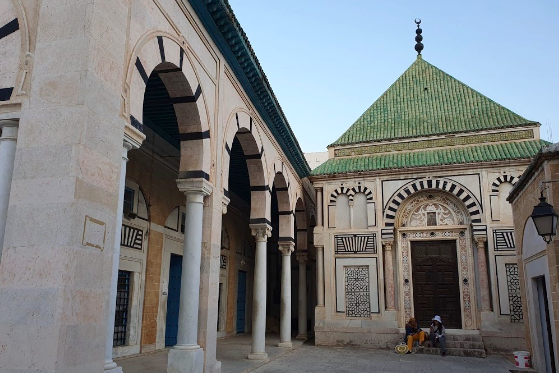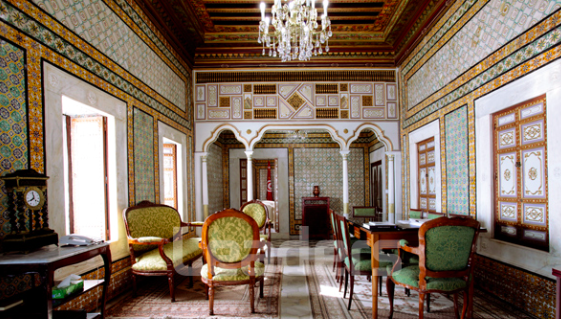The Inexhaustible Delights of Tunis's Kasbah
By: Habeeb Salloum/Arab America Contributing Writer

“It’s the richest and best preserved medina (Arab city) from the Islamic medieval world”, I remarked to a friend from Montreal as we made our way to Tunis’s Kasbah, the romantic name of the Medina. I had visited it a number of times before and had been very impressed by this quaint part of Tunis’s capital. “They are different worlds, this modern Boulevard Habib Bourguiba which is considered Tunis’s Champs Elysées, and the old town. The souks (market streets) of the Medina are much more fascinating.” I wanted my companion to join in my excitement at the thought of exploring the souks of the kasbah.
In a few minutes we were at Bab Behar (Sea Gate), better known as Porte de France – once one of the 17 gates in the city’s medieval ramparts which for the greater part are now torn down. A few feet inside, and we were walking up Rue Jamaa ez-Zitouna, crowded with masses of people who gently and courteously passed each other. The cleanliness of these streets and connecting lanes was astounding. I had visited a good number of the major cities in North Africa, but this appeared to be the quietest and most garbage-free medina i had seen.

Every inch edging Rue ez-Zitouna was covered by colorful handicraft products -some being produced by artisans under the watchful eyes of tourists. Exquisitely engraved brass and copper plates, handwoven rugs, silver products, ceramics, all types of leather articles, traditional Tunisian clothing and delightful filigree style bird cages crammed the shelves of the tiny stalls. It was a world of sheer shopper’s delight. The only annoyance was a few aggressive merchants who attempted to pressure us to buy their wares at inflated prices.
We walked through this commercial scene from the Middle Ages until we reached Jamaa ez-Zitouna, the city’s Great Mosque. Its foundation was laid in 732, but it was not completed until 864 A.D. and, thereafter, its minaret has dominated the medina.
From its inception, ez-Zitouna was an important Arab-Islamic university. However, in the last few decades it’s just faculties have been amalgamated with those of the University of Tunis and it has become only an influential religious center. Unlike the mosques in Algeria and Morocco, its courtyard, as are most other courtyards of mosques in Tunisia, is open to non-Muslim visitors.
Around the mosque comma the shops, eating places and busy life of the Medina reached the epitome of color and movement. For us comma the most interesting spot was Souk el-Attarine (Perfumers’ Street) hugging one of the mosques walls. Here, wedding knickknacks and all types of natural perfumes and hair dyes were on display. We were intoxicated by the scent of roses, jasmine and incense which engulfed the street and seemed to create a magical effect – an aesthetic sense of pleasure. It was easy to see how this aroma and the colorful decorations of the shops with their polite owners have made it a favored shopping souk for tourists.
From Souk el-Attarine we strolled a short distance to examine the green-roofed 18th century Hamouda Pacha Mosque, built by the Ottoman Turks who at that time were the rulers of Tunisia. The most appealing part of the mosque is its attractive rounded minaret, a type to be seen in every country where the Turks once ruled – much different than the square ones, common in North Africa.

Nearby, we plunged into the labyrinth of narrow side streets and covered passageways of the Medina. Every alleyway seemed to be bursting with masses of people moving between picturesque stalls, offering almost everything under the sun. We had a vibrant feeling as we wandered randomly, stumbling on unexpected sites. Hand manufacturers of the chichia (former Tunisian headgear which is now only worn by the elderly), cobblers, saddle makers, silversmiths and tailors, working at their crafts, took us back to the days of long ago. For tourists seeking handmade products, it is a great shopping centre.
Around every other corner, amid the shops, we found centuries-old buildings which have kept their original charms. With their elaborate stonework, decorated doors and windows, they enhance the tiny laneways and squares. Their medieval aura complemented and made more delightful the souks of the Medina.
Leaving this exotic mercantile world, we moved on to search for historic sites. However, the day was getting late and we had only time to visit only two of the some 700 timeworn monuments, dotted throughout the Kasbah.
How our first stop was Dar Ben Abdallah, a palace built in the 19th century which now houses the Museum of Folklore and Popular Art. Here, we rested for a while in the midst of its evocative decor of fine tiles, surrounded by filigree.
Refreshed, we ambled for 20 minutes to Dar el Bay a former magnificent palace of Tunisia’s beys (kings). Now converted to government offices, it’s inside is not open to the public. Nevertheless, our walk was not in vain. Its eye-catching Moorish-type architecture crowned our day of exploration.

Feeling famished after hours of wandering, we retraced our steps to near Jamaa ez-Zitouna where we had seen a series of people’s restaurants. In a typical Tunisian eating place, we dined on brik (egg pie), a Tunisian tuna salad and couscous, the king of North African cuisine. The $5 meal was tasty, but the atmosphere left much to be desired. It was a place to eat, then quickly depart. I remarked to my friend as we walked away, “The multiple delights of Tunisian food are not to be found in the eating places of the masses.”
The next night it was a different story. WE dined in style on a sumptuous meal in the M’Rabet Restaurant near Dar el Bey. The cost was over six times more, but this was more than made up for by the attractive surroundings and superb oriental entertainment. The excellent food, colourful folklore and swaying dancer fitted well into the Medina’s world of inexhaustible delights – a nostalgic never-never land from the ‘Arabian Nights’.








